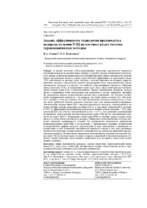| dc.contributor.author | Седнин, В. А. | |
| dc.contributor.author | Игнатович, Р. С. | |
| dc.coverage.spatial | Минск | ru |
| dc.date.accessioned | 2023-08-15T07:38:16Z | |
| dc.date.available | 2023-08-15T07:38:16Z | |
| dc.date.issued | 2023 | |
| dc.identifier.citation | Седнин, В. А. Анализ эффективности технологии производства водорода на мини-ТЭЦ на местных видах топлива термохимическим методом = Analysis of the Efficiency of Hydrogen Production Technology at Mini-CHP Plants Using Local Fuels by Thermochemical Method / В. А. Седнин, Р. С. Игнатович // Известия высших учебных заведений и энергетических объединений СНГ. Энергетика. – 2023. – № 4. – С. 354-373. | ru |
| dc.identifier.uri | https://rep.bntu.by/handle/data/133663 | |
| dc.description.abstract | В рамках политики «обезуглероживания» экономики предлагается технология получения водорода из местных видов топлива и горючих отходов человеческой деятельности в рамках развития функциональности теплофикационных циклов производства энергии. Целью исследования является оценка энергетической эффективности паросиловой мини-ТЭЦ, работающей на местных видах топлива, с модулем производства водорода термохимическим способом. Представлен краткий литературный обзор термохимических циклов производства водорода и показано, что наиболее перспективными считаются гибридные циклы медь-хлор Cu–Cl. В программной среде Aspen Hysys была синтезирована математическая модель мини-ТЭЦ с пятиступенчатым циклом производства водорода, которая может в дальнейшем быть использована как компонент в составе цифрового двойника. По результатам анализа математической модели было определено, что удельное потребление электрической энергии на 1 кг водорода для такой схемы составит 9,11 (кВт ч)/кг, что в среднем в пять раз меньше, чем при производстве водорода электролизом, остальная часть требуемой энергии замещена тепловой, при этом максимальный коэффициент использования топлива мини-ТЭЦ с модулем производства водорода, использующей в качестве топлива отходы древесины, составил 83,1 %, в том числе тепловой КПД составляет 51,5 %, эффективность производства водорода по низшей теплоте сгорания – 31%, электрический КПД по отпуску электроэнергии в сеть – 0,6 %. Для сравнения максимальный коэффициент использования топлива паросиловой мини-ТЭЦ той же электрической мощности достигает 90,9 %. Расширение опций мини-ТЭЦ на местных видах топлива путем ввода в ее схему блока производства водорода гибридным термохимическим методом позволяет повысить маневренность станции, что предполагает возможность организации функционирования мини-ТЭЦ в соответствии с требованиями тепловых потребителей и электрического графика нагрузок энергосистемы в часы максимумов и минимумов ее потребления за счет изменения электрической мощности отпуска в сеть или увеличения мощности потребления электроэнергии из внешней сети до мощности, требуемой для производства водорода. В заключение указывается на возможность развития исследуемой схемы мини-ТЭЦ на местных видах топлива в сторону дальнейшей утилизации продуктов сгорания с целью генерации искусственного природного газа, который в этом случае можно назвать «зеленым». | ru |
| dc.language.iso | ru | ru |
| dc.publisher | БНТУ | ru |
| dc.title | Анализ эффективности технологии производства водорода на мини-ТЭЦ на местных видах топлива термохимическим методом | ru |
| dc.title.alternative | Analysis of the Efficiency of Hydrogen Production Technology at Mini-CHP Plants Using Local Fuels by Thermochemical Method | ru |
| dc.type | Article | ru |
| dc.identifier.doi | 10.21122/1029-7448-2023-66-4-354-373 | |
| local.description.annotation | Within the framework of the policy of “decarbonization” of the economy, a technology for hydrogen producing from local fuels (LF) and combustible waste of human activity is proposed as a part of the development of the functionality of heating cycles of energy production. The aim of the present study is to evaluate the energy efficiency of a steam-powered mini-CHP plant operating on local fuels with a thermochemical hydrogen production module. A brief literature review of thermochemical cycles of hydrogen production is presented, and it is shown that hybrid copperchlorine Cu–Cl cycles are recognized as the most promising. In the Aspen Hysys software environment, a mathematical model of a mini-CHP plant with a five-stage hydrogen production cycle was synthesized, which can later be used as a component in the digital twin. According to the results of the analysis of the mathematical model, it was determined that the specific consumption of electric energy per 1 kg of hydrogen for such a scheme will be 9.11 (kWh)/kg, which is on average more than five times less than in the production of hydrogen by electrolysis, the rest of the required energy is replaced by thermal one, while the maximum fuel utilization factor of mini-CHP with a hydrogen production module using wood waste as fuel amounted to 83.1 %, including a thermal efficiency of 51.5 %, the efficiency of hydrogen production at the lowest calorific value is 31 %, the electrical efficiency for the supply of electricity to the grid is 0.6 %. For comparison, the maximum fuel utilization of a steam-powered mini-CHP of the same electrical capacity reaches 90.9 %. The expansion of mini-CHP options operating on local fuels by introducing a hydrogen production unit by hybrid thermochemical method into its scheme makes it possible to increase the maneuverability of the station, which implies the possibility of organizing the operation of mini-CHP in accordance with the requirements of thermal consumers and electrical graphreducing the loads of the power system during the hours of maxima and minima of its consumption by changing the electrical power supply to the network or increasing the power consumption of electricity from the external network to the power required for hydrogen production. In conclusion, the possibility of developing the studied scheme of a mini-CHP operating on local fuels towards further utilization of combustion products in order to generate artificial natural gas, which in this case can be called “green”, is indicated. | ru |

